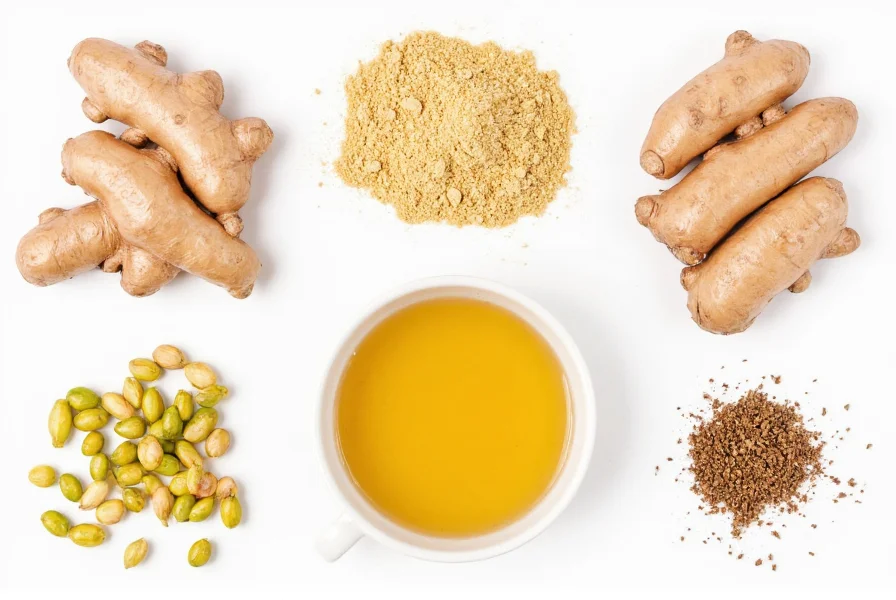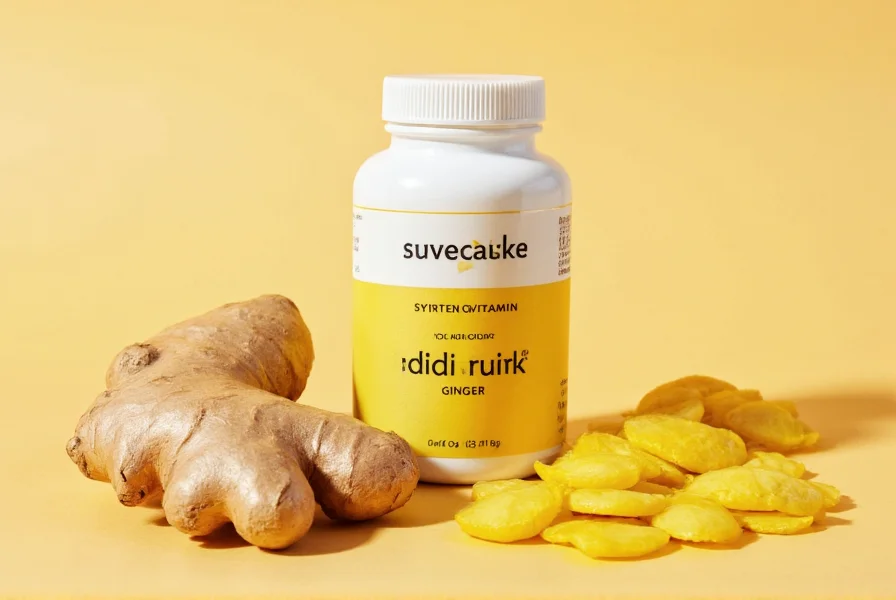Ginger has been used for centuries in traditional medicine, but confusion often arises about its nutritional profile, particularly regarding vitamins. Let's clarify the facts about ginger's vitamin content and its role in a healthy diet.
Understanding Ginger's Actual Nutritional Composition
Ginger root (Zingiber officinale) is primarily composed of carbohydrates, fiber, and water. While it does contain some vitamins, these are present in relatively small quantities. One tablespoon (about 6 grams) of raw ginger contains approximately:
| Nutrient | Amount per Tbsp (6g) | % Daily Value |
|---|---|---|
| Vitamin B6 | 0.04 mg | 2% |
| Vitamin C | 0.7 mg | 1% |
| Magnesium | 7 mg | 2% |
| Potassium | 30 mg | 1% |
This nutritional breakdown shows that while ginger does contain vitamins, particularly vitamin B6 and small amounts of vitamin C, these quantities are not substantial enough to consider ginger a significant vitamin source. The misconception of “ginger vitamin” likely stems from ginger's well-documented health benefits, which are primarily due to its bioactive compounds rather than vitamin content.

Ginger's Primary Health Benefits Come From Bioactive Compounds
The confusion between ginger and vitamins often overlooks what makes ginger truly valuable: its unique bioactive compounds. Gingerol, the main active component in fresh ginger, is responsible for most of ginger's health benefits:
- Nausea relief - Multiple studies show ginger effectively reduces nausea from pregnancy, chemotherapy, and motion sickness
- Anti-inflammatory effects - Gingerol inhibits inflammatory pathways in the body
- Digestive support - Stimulates digestive enzymes and gut motility
- Pain reduction - May help with menstrual pain and osteoarthritis
- Antioxidant properties - Helps combat oxidative stress
These benefits operate through different mechanisms than vitamins, which explains why ginger shouldn't be considered a vitamin replacement. Research published in the International Journal of Preventive Medicine confirms that ginger's therapeutic effects primarily come from its phenolic compounds, not its vitamin content.
Comparing Ginger to Actual Vitamin Sources
To understand why ginger shouldn't be relied upon for vitamin intake, consider these comparisons:
| Nutrient | Ginger (1 oz) | Actual Vitamin Source | Comparison |
|---|---|---|---|
| Vitamin B6 | 0.1 mg (6% DV) | Chickpeas (1 cup) | 1.1 mg (65% DV) |
| Vitamin C | 2 mg (2% DV) | Orange (1 medium) | 70 mg (78% DV) |
| Magnesium | 15 mg (4% DV) | Almonds (1 oz) | 80 mg (19% DV) |
This comparison clearly shows that while ginger vitamin content exists, it's minimal compared to foods specifically rich in these nutrients. You would need to consume unrealistic amounts of ginger to meet daily vitamin requirements.
Practical Ways to Benefit From Ginger's Properties
Instead of viewing ginger as a vitamin source, incorporate it strategically for its actual benefits:
- For nausea relief: 1-1.5 grams of ginger daily (about 1 teaspoon of fresh grated ginger)
- For inflammation: 2 grams of ginger extract daily, or 10 grams of fresh ginger
- For digestive support: Consume ginger 30 minutes before meals
These amounts provide therapeutic benefits without expecting significant vitamin intake. A study in Nutrition Journal found that 2 grams of ginger daily significantly reduced muscle pain, demonstrating effective dosing for specific benefits.

Common Misconceptions About Ginger and Vitamins
Several myths persist about ginger's vitamin properties:
- Myth: “Ginger is a good source of vitamin C” Fact: While ginger contains some vitamin C, you'd need to eat over 30 grams of fresh ginger to get the same vitamin C as half an orange
- Myth: “Ginger supplements provide essential vitamins” Fact: Most ginger supplements standardize for gingerol content, not vitamins
- Myth: “Ginger can replace vitamin B supplements” Fact: Ginger's vitamin B6 content is minimal; it cannot address B vitamin deficiencies
Understanding these distinctions helps you use ginger appropriately as part of a balanced diet rather than mistakenly relying on it for vitamin needs.
When Ginger Complements Vitamin Intake
While not a significant vitamin source itself, ginger can enhance the absorption of certain nutrients:
- Ginger's digestive properties may improve absorption of fat-soluble vitamins (A, D, E, K) when consumed with healthy fats
- Its anti-inflammatory effects may help reduce nutrient-depleting inflammation in the body
- Ginger can make vitamin-rich foods more palatable, encouraging greater consumption of nutrient-dense meals
For example, adding ginger to vegetable stir-fries not only enhances flavor but may improve the bioavailability of nutrients in those vegetables, creating a synergistic effect for overall nutrition.
Conclusion: Using Ginger Appropriately in Your Diet
Ginger is a valuable dietary component with numerous health benefits, but it shouldn't be confused with a vitamin source. Its minimal vitamin content, particularly vitamin B6 and trace vitamin C, shouldn't be the primary reason for consumption. Instead, appreciate ginger for what it does best: providing anti-nausea effects, reducing inflammation, and supporting digestion through its unique bioactive compounds.
For optimal health, incorporate ginger as a complementary element in a varied diet rich in actual vitamin sources. This approach ensures you receive both the specific benefits of ginger and adequate vitamin intake from appropriate foods.
Is ginger considered a vitamin supplement?
No, ginger is not a vitamin supplement. While it contains small amounts of vitamin B6 and trace vitamin C, these quantities are too minimal to qualify ginger as a significant vitamin source. Ginger's health benefits primarily come from bioactive compounds like gingerol, not vitamin content.
Does ginger contain vitamin C?
Yes, ginger contains small amounts of vitamin C. One ounce (28g) of raw ginger provides about 5 mg of vitamin C, which is approximately 6% of the daily value. However, this is significantly less than dedicated vitamin C sources like oranges (70mg per medium fruit) or bell peppers (95mg per medium pepper).
Can ginger replace vitamin B supplements?
No, ginger cannot replace vitamin B supplements. While ginger contains vitamin B6, the amount is minimal (about 0.1mg per ounce, or 6% of daily value). To meet daily vitamin B6 requirements (1.3-1.7mg for adults), you would need to consume unrealistic amounts of ginger, which could cause digestive discomfort.
What are the actual health benefits of ginger?
Ginger's primary health benefits include reducing nausea (particularly during pregnancy and chemotherapy), decreasing inflammation, supporting digestion, alleviating muscle pain, and providing antioxidant protection. These benefits come from bioactive compounds like gingerol, not from vitamin content.
How much ginger should I consume daily for health benefits?
For general health benefits, 1-3 grams of fresh ginger daily is recommended. For specific conditions: 1-1.5 grams for nausea relief, 2 grams for inflammation reduction, and consuming ginger 30 minutes before meals for digestive support. This provides therapeutic benefits without expecting significant vitamin intake.











 浙公网安备
33010002000092号
浙公网安备
33010002000092号 浙B2-20120091-4
浙B2-20120091-4